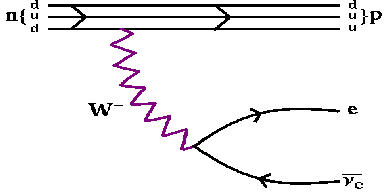One of the four fundamental forces, about a million times weaker than the strong force – hence the name - the weak interaction involves the exchange of the intermediate vector bosons, the W and the Z. Since the mass of these particles is on the order of 80 GeV, the uncertainty principle dictates a range, using the Heisenberg Uncertainty Principle, of about
which is about 0.1% of the diameter of a proton.
The weak interaction changes one flavour of quark into another. It is crucial to the structure of the universe in that
1. The sun would not burn without it since the weak interaction causes neutrons to decay into protons so that deuterium can form and deuterium fusion can take place.

2. It is necessary for the buildup of heavy nuclei since this involves the production of neutrons, which have a half life of only 15 minutes, decaying back into protons – illustrated below, with a d -quark changing into a u -quark plus a W – boson which then decays into an electron plus an anti – neutrino.
The role of the weak force in the transmutation of quarks makes it the interaction involved in many decays of nuclear particles which require a change of a quark from one flavour to another. It was through beta decay that the existence of the weak interaction was first revealed. The weak interaction is the only process in which a quark can change to another quark, or a lepton to another lepton - the so-called "flavour changes".
The discovery of the W and Z particles in 1983 was hailed as a confirmation of the theories which connect the weak force to the electromagnetic force in electroweak unification.
The weak interaction acts between both quarks and leptons, whereas the strong force does not act between leptons. Leptons have no color, so they do not participate in the strong interactions; neutrinos have no charge, so they experience no electromagnetic forces; but all of them join in the weak interactions.
